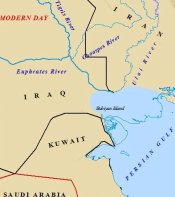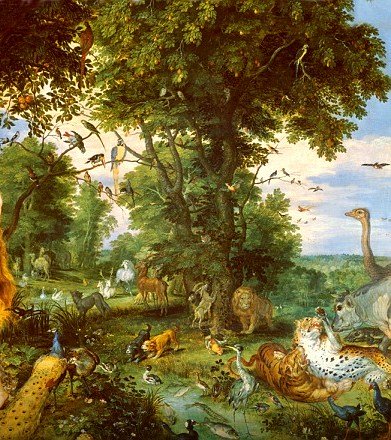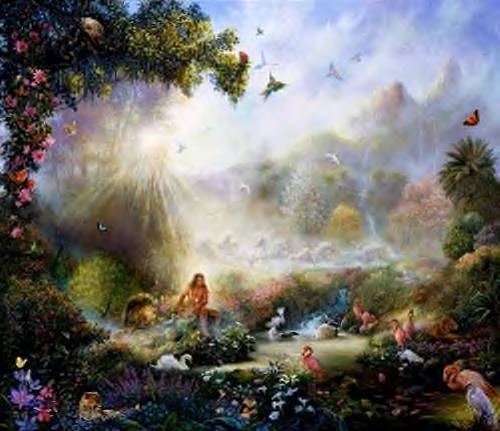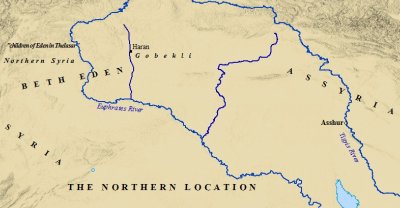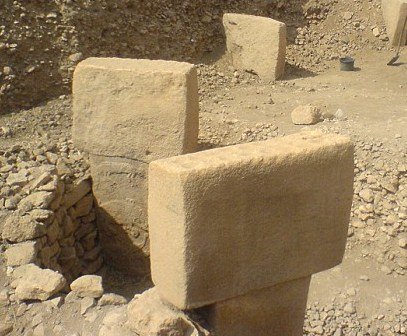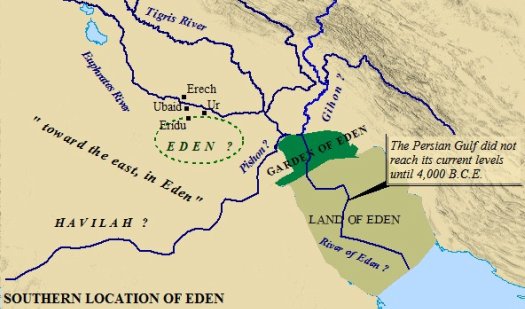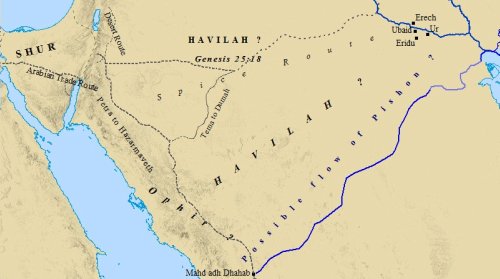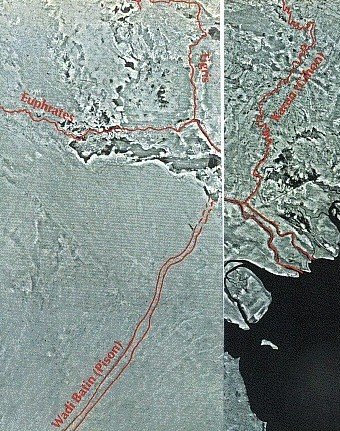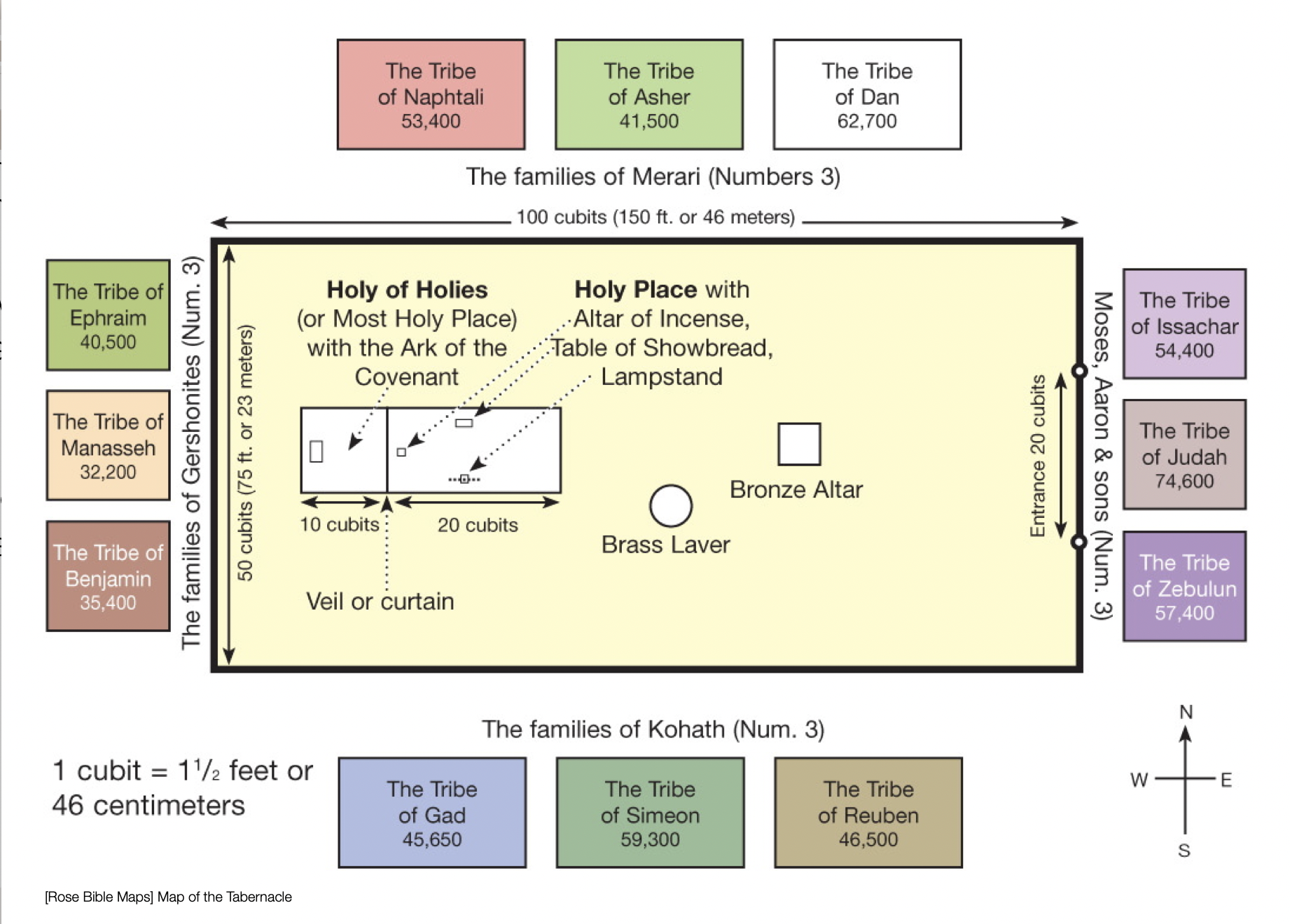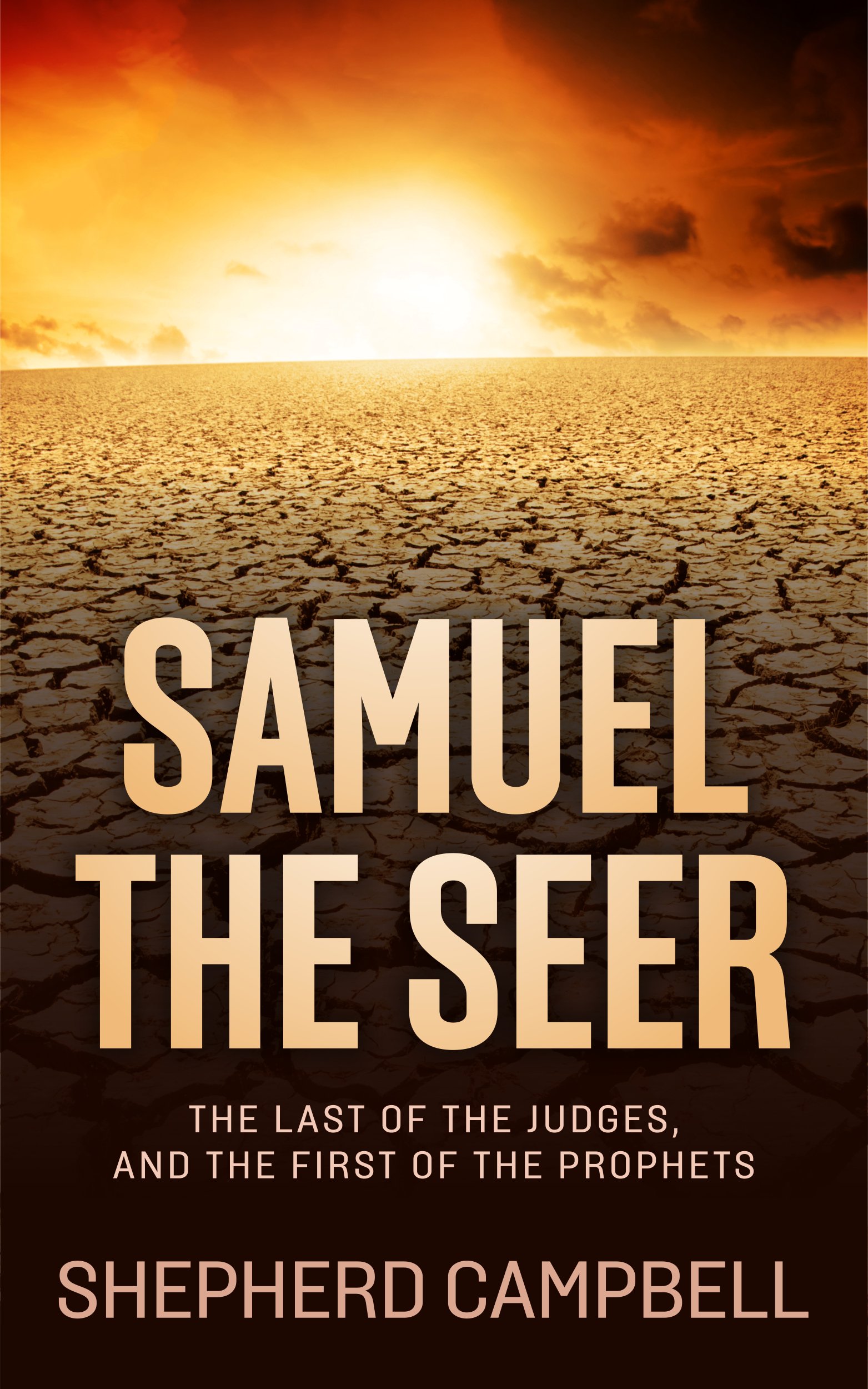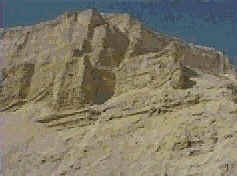VISIT OUR FACEBOOK PAGE!
Biblical Garden of Eden
Click on the link below to jump to that section of the Biblical Garden of Eden
The Tree of the Knowledge of Good and Evil
The Southern Location of Eden
THE GARDEN OF EDEN
Though the location of the Garden of Eden is a debatable topic, the description of it in Genesis leaves no question as to the beauty and extravagance of God's garden.
This was the perfect home for man. It was created before sin. It's
beauty was perfect. The lush vegetation contained fruit and trees not seen on earth since. The environment existed in a perfect state of harmony, as man and animal coexisted without death or threat. A river is said to "wander" through the Biblical Garden of Eden. This river was just one source of water for the Garden. Its origin was somewhere within the Land of Eden. This river was fed through the subterranean reservoirs (Gen. 2:6) that made up the antediluvian (Pre-Genesis flood)
water cycle. The environment was in a perfect state of balance - like a huge green house.
The story of the Biblical Garden of Eden, however, first begins with what God had planted in the Garden which helped contribute to its Divine uniqueness. The word Eden literally means, "delight". It was a garden of delight, full of heavenly fruit growing on trees! Genesis 2:9 describes God's handiwork.
"And out of the ground the Lord God caused to grow every tree that is pleasing to the sight and good for food.."
This garden was full of color, a beautiful array of flowering colors pleasing to the sight. The aroma was surely one of sweetness, and the food brought healing to Adam and Eve's mortal bodies. It was pure paradise. Two trees, however, stood out among the others.
The Trees of Eden
"And the Lord God had planted a garden in the east.....And the Lord God made all kinds of trees grow out of the ground-trees that were pleasing to the eye and good for food. In the middle of the garden were the tree of life and the tree of the knowledge of good and evil." - Gen. 2:9
In the Biblical Garden of Eden grew two remarkable trees. Whether these were in the middle of the Garden, are simply within the Garden is of debate. What is important is the instructions regarding these trees issued by God to Adam. It is also important to keep in mind God issued the command initially to Adam only - as Eve had not yet been created. This seemingly useless observation plays a key role in the events to follow. Genesis 3:22 mentions that the fruit from one of these trees produced eternal life.
God specifically says that man must not be allowed to "reach out his hand and take also from the tree of life and eat, and live forever". God instructs Adam to eat from any tree in the Biblical Garden of Eden, except for the "tree of the knowledge of Good and Evil". He never makes any mention about not eating from the Tree of Life. Adam, and later Eve, were meant to enjoy the fruit of this heavenly tree at will. In essence, this tree would enable Adam and Eve to live forever. It possessed divine powers of healing and regeneration.
Only after Adam and Eve disobeyed regarding the Tree of the Knowledge of Good and Evil does He restrict them from the Tree of Life. It is quite remarkable to think that God took the gift of eternal life and originally included it in a fruit! The Tree of Life possesses a fascinating place in Scripture. This tree possessed such powers that it became necessary to place a Cherubim and a flaming sword in front of it to prevent man from eating of it. The Cherubim, according to Ezekiel, was the highest of the angelic realm (Ezekiel 1:4-28; 10:1-22).
In Revelation 22:2 it is this same Tree of Life that stands on each side of the River of the Water of Life, which flows through the New Jerusalem , established when the Messiah comes again. The tree is said to bear "twelve crops of fruit, yielding its fruit every month. And the leaves of the tree are for the healing of the nations".
God intended to bring forth healing and life to Adam and Eve through this Tree of Life. When His kingdom is established on earth, its leaves will bring healing and life to the nations.
The Tree of the Knowledge of Good and EvilGenesis 3:22
"And the Lord God said, 'The man has become like one of us, knowing good and evil. He must not be allowed to reach out his hand and take also from the tree of life and eat, and live forever.' "
Along with the Tree of Life, God planted the Tree of the Knowledge of Good and Evil in the Biblical Garden of Eden as well. This tree is of special significance, because it is from this tree that God specifically told Adam, who likely relayed the message to Eve after her creation, not to eat from whatsoever. The consequence for eating from this tree was death. They had free use of any and every other tree in the Garden, including it would seem the Tree of Life. The ONLY exception was for the Tree of the Knowledge of Good and Evil.
Exactly why God did not want Adam and Eve eating from this tree
is not said. However, a careful study of the scripture lends some
insights. The first insight is given by none other than the serpent himself. In Genesis 3:5 the serpent tells Eve that by eating from the tree their "eyes will be opened, and you will be like God". Notice it is Eve the Serpent approached. As she was not present when God issued the original command, the serpent was completely aware of this fact and perceived her to be the weakest link. Ziony Zevit has a fascinatingly unique approach to this narrative. He emphasizes the point God spoke only to Adam originally; and the Serpent tempted Eve specifically because of she was not present for the original command.
In Genesis 3:22 man is said by God to have become "like one of us, knowing good and evil". Interestingly it is the knowledge of the difference between good and evil that makes man like God. As stated earlier, Adam was created outside the Biblical Garden of Eden, then placed there by God after God had created him. The only existence Adam and Eve knew was one of perfection. The only image they had of God was as a loving, providing, and faithful Father.
Once they ate from the Tree of the Knowledge of Good and
Evil, they had broken the balance of perfect existence through
disobedience to the Father. Man was forever doomed to a life of toil and
restlessness, with pressures, temptations and adversity at every
corner. Sin had brought the judgment and condemnation of the Father into
the world. It was a side of God Adam and Eve had never seen before. The
Biblical Garden of Eden would be no more. The harmony between God and man had been interrupted and permanently changed.
The Location of the Garden of Eden
The hottest topic regarding the Biblical Garden of Eden is the location of Eden. Two sites provide the most tantalizing evidence, and both are legitimate sites. The first place to start when trying to locate the Garden of Eden is in the Bible. Genesis 2:14 gives the location of the Garden of Eden.
"Now a river flowed out of Eden to water the garden; and from there it divided and became four rivers.(10)"
Thus the Bible differentiates between the Garden of Eden, and the land of Eden as we touched on above. The garden was merely a part of the whole land of Eden. A river flowed from an unknown source somewhere in Eden, and continued to flow throughout all of the land of Eden. The river flowed into the Garden of Eden and watered the garden's lush vegetation, along with the subterranean water reservoirs. As the river flowed forth from the Biblical Garden of Eden it split into four headwaters. These formed the four rivers mentioned in Genesis.
The name of the first river is the Pishon River (v.11). It is said to have "flown around the whole of the land of Havilah, where there is gold." The second river is called the Gihon River. The Gihon is said to have flowed around the land of Cush. Cush is a controversial interpretation of the Hebrew word used to represent a geographical region known as "Gush", or, "Kush". The King James translated it as "Ethiopia", or, "Cush". This created geographical problems for scholars of the Biblical Garden of Eden. However, scholar Ephraim Speiser put forth an intriguing theory. He argues the geographical region implied is that of the Kashshu, or the Kashites. This would place the Gihon branching to the east, into Iran and the Zagros Mountains.
The third river mentioned is the Tigris. Scripture says it ran east of Assyria, as it does in modern day times. The fourth river is the Euphrates. The location of these two rivers are agreed by many to be as they are today. The question rests in the identity of the first two rivers mentioned; the Pishon, and the Gihon.
The Northern Location of the Garden of EdenThe theory supporting the Biblical Garden of Eden in Turkey rests on fascinating ruins found at Gobekli. The location of Gobekli also plays a role. It is located on the plains of Haran, in Turkey. The Biblical area is termed Aram-Naharaim. Haran was named after Abraham's brother, and the area has many strong ties to the early Patriarchs.
The ancient city of Sanliurfa rests a mere ten miles to the southwest. Muslims associate Sanliurfa with the birthplace of Abraham. Gobekli is certainly located in some of the holiest areas in the Old Testament.
However, it is what was found at Gobekli which raised eyebrows. Massive megalithic T shaped stones were unearthed. Forty-five of these stones have been unearthed thus far, yet geological surveys show many more still buried below. These stones are arranged in circles, and clearly represent an ancient center of worship. Carved on these stones are dazzling images of various kinds. Themes of hunting permeate the inscriptions, and many images have been found of boars, lions, fish, ducks and more. Serpents are depicted frequently on the stone megaliths. Many of the stones appear to take on human forms, with arms hanging from the sides. The site is reminiscent of Stonehenge in many ways.
The staggering characteristic of Gobekli, which ties it to the Biblical Garden of Eden, is its age. Carbon dating have placed the ruins at Gobekli to have been built between 12,000 - 13,000 years ago! That would place these stones around 10,000 B.C.E. One must consider Stonehenge was built in 3,000 B.C.E., and the Great Pyramid of Giza was built around 2,500 B.C.E. Gobekli, thus, is the oldest site on earth, pre-dating Stonehenge and Giza by perhaps seven thousand years! Gobekli also fits some geographical requirements for the location of the Garden of Eden. It is west of Assyria, which the Bible places Eden. Gobekli lies between the Tigris and Euphrates, as does the Biblical Garden of Eden. There are other references in the Old Testament which lend credence to Gobekli.
The Old Testament makes mention of "children of Eden which were in Thelasar". Thelasar is a town in northern Syria , near Gobekli. These children of Eden were perhaps the same as the Beth-Eden, or, house of Eden, mentioned in ancient Assyrian texts. It becomes apparent this area in Turkey holds spiritual significance in many ways. The abandonment of Gobekli is interesting as well. Around 8,000 B.C.E., the inhabitants of Gobekli inexplicably buried their temple under tons of earth. These people used so much earth artificial hills were created. The ruins remained untouched for over ten thousand years, until discovered in 1994 by a shepherd wandering through the hills. No reason can be determined for the sudden burial of Gobekli. However, it accounts for the amazing preservation of the ruins found at this mysterious and ancient site.
A natural criticism of this theory is the absence of the Pishon and Gihon rivers. The location of Gobekli seems to allow only for two of the four rivers, thus many scholars and historians dismiss this site as Eden. These tend to focus their attention on the southern location for the Biblical Garden of Eden. In any way, it cannot be denied the discovery at Gobekli is fascinating. The implications that man was able to build such a site several thousand years before Stonehenge forces much of what we know about the ancients to be re-evaluated. The site is a testament to the mysteries of the ancient world.
Where do you think the Garden of Eden may be located? Which theory do you find most convincing? What other insights do you have? Give us your insights, thoughts, questions, and comments!
THE BIBLICAL GARDEN OF EDEN
Southern Location for the Biblical Garden of Eden
HAVILAH
The region of Havilah has an interesting place in the Bible. Genesis 10:7 lists one of Cush's son's name as Havilah, as well as a son of Joktan in Genesis 10:29. Cush was a descendant of Ham, and Joktan of Shem. Ham and Shem were two of the sons of Noah who survived the flood. Havilah, believed to mean Sandland, possessed an abundance of gold and precious stones and substances. Surely Adam and Eve spent time exploring this rich and extravagant land. Havilah had made quite an impression on the descendants of Adam. Havilah is later said to have been where Ishmael settled (Gen. 25:18). Ishmael is said to have settled from "Havilah to Shur, which is east of Egypt".
The Christian Geology Center has put out an interesting study in which these stones are critical in helping locate the Biblical Garden of Eden. Genesis 2:11-12 describe the land of Havilah.
"The name of the first is Pishon; it flows around the whole land of Havilah, where there is gold. And the gold of that land is good; the bdellium and onyx stone are there."
These substances were not found within the borders of Mesopotamia. The gold of this passage rest in the land of Havilah. Bdellium came only from Southern Arabia and Somaliland in antiquity. The exact nature of the onyx stone is not known, however, precious stones were being brought into Israel and Mesopotamia through Arabia during times antiquity.
Though the exact location of Havilah is not agreed upon unanimously, Scripture indicates it lie in Arabia, perhaps modern day Saudi Arabia. Indeed, the most ancient gold deposit on earth rests in Saudi Arabia, at modern day Mahd adh Dhahab. Mahd adh Dhahab was the largest, and one of the most richest, gold mines in antiquity. Many scholars believe Solomon obtained his gold from this mine. They also feel as if Mahd adh Dhahab is, more than likely, the Biblical Ophir.
Thus, even before the time of Abraham , trade had been established between the desert regions of Arabia, Israel and Mesopotamia . These ties dated back to the very earliest times in human history. The problem with this location is that no river runs across Saudi Arabia. The Biblical Garden of Eden had four rivers which spread forth from it. If the Garden was in the Persian Gulf area of southern Iran/Kuwait, then there would have to be a river, or evidence of one, stretching across the desert.
The Wadi al Batin has enticed scholars for decades as being a possible candidate for the Pishon River, thus connecting Eden with Havilah.
The Wadi al Batin breaks to the southwest of the Persian Gulf, along the borders of Kuwait, and into Saudi Arabia. Once in Saudi Arabia, the Wadi is swallowed by vast and massive sand dunes. It was here the Wadi al Batin was thought to have stopped flowing. However, satellite images have recently produced photographs of a stunning nature. The Wadi al Batin actually continues to the southwest - across the desert. Pictures revealed dried up river beds buried beneath the massive expanse of sand dunes running through the entire length of Saudi Arabia! The Wadi al Batin emerges as the Wadi Rimah, which continues up stream about 80 miles before it splits in two. One branch verges to the northwest, the other to the southwest. These wadis and tributaries were all once part of the same river system - thousands of years ago. The southwest branch of the Wadi Rimah actually continues to the area of the Mahd adh Dhahab gold mine! This is in exact agreement with Scripture.
"The name of the first is the Pishon, it flows through the whole land of Havilah, where there is gold."
This would seem to be in exact agreement with the Biblical Garden of Eden and the description of the rivers flowing forth from it. Thus, the Pishon may be identified as the Wadi al Batin, which continues underground in a dried up ancient river bed, and emerges around the oldest, most prolific gold mine of antiquity. The satellite images are concrete evidence a river once ran through the deserts of Saudi Arabia. This ancient river stretched through and around the entire land of Saudi Arabia, and also flowed near an ancient gold mine in Saudi Arabia - one of the richest in antiquity. The coincidences, if they are such, are indeed staggering.
This leaves the second river mentioned flowing from the Biblical Garden of Eden in Genesis 2: 13. This is the Gihon River.
"And the name of the second river is Gihon: it flows around the whole land of Cush."
The King James Version translated the Hebrew word, "Kush", as the Cush of Ethiopia. This has thrown a wrench into many a theories on the location of the Garden of Eden. The answer to this problem may not be so complex.
As briefly mentioned above, Biblical scholar Ephraim Speiser proposed the "Gush", or "Kush", translated as Cush, meant to imply the Kashshu. The Kashshites overran Mesopotamia in 1500 B.C.E. These people dwelt east of Mesopotamia from the years 1800-1600 B.C.E. The land before the Kashshu was known as Elam, or Susa. The phrasing is also interesting. The Gihon is said to "compasseth" the whole land. The Hebrew term literally means; to twist and turn, to take roundabout course.
With this in mind, the most likely candidate would be the Karun River. The Karun and Karkheh rivers provided ancient Mesopotamia with vital trade routes into Elam and Susa. The people of this day would have been very familiar with the Gihon River and the land of Kush, whose inhabitants were known as the Kashshites (Kassites). The Karun river runs a course of over 500 miles. However, the river is only 175 miles in length. It runs a zigzagging, meandering course through the Zagros Mountains.
The Karun and Karkheh, up until the 10th century A.D., emptied
into the Persian Gulf. This would have occurred east of the Tigris. The
Karun, thus, could have flown into the River of Eden, fitting precisely
with the description in Genesis. An intriguing theory by scholars has placed the Biblical Garden
of Eden underneath Bubiyan Island. Interesting evidence exists
underneath this island which suggests at one point the land was dry. In
fact, up until 8,000 B.C.E., the entire Persian Gulf is thought to have
been a dry river valley. Though the Southern Location possesses many fascinating
characteristics, the ruins at Gobekli are just as fascinating evidence
of the possible site of the Biblical Garden of Eden in the north. Perhaps further
archaeology, assisted by developing technology, will one day unearth,
without a doubt, the mysterious location of the Garden of Eden. Until
then, theories will abound and the inquisitive will still search.
Click to See the Comments of Others on The Biblical Garden of Eden
Back to the Top
Back to Ancient Israel
Back to Home Page
Recent Articles
-
The Tabernacle
Feb 27, 25 04:47 PM
The Tabernacle was where Yahweh met with his people before the First Temple was built. It was also called the Tent of Meeting. -
The Tabernacle of Moses
Feb 19, 25 09:50 AM
The tabernacle of Moses was built by Moses, per instruction from God, during the Exodus out of Egypt. It represented God's presence amongst His people. -
The Ark of the Covenant
Feb 19, 25 09:46 AM
The Ark of the Covenant is one of the most mystifying objects in all of human history. It's power was so great that Israel often carried it to the front lines. -
King David of Israel
Feb 19, 25 12:51 AM
The story of King David of Israel is a rags-to-riches tale of the family runt rising to national King. King David would become Israel's greatest king. -
The Nephilim
Feb 15, 25 10:35 PM
Were the Nephilim byproducts of fallen angels and women? Enoch wrote it was so, as did Moses. What mysteries lie buried in the pages of the Old Testament?
Share Your Thoughts & Comments on Eden
Do you have a theory as to where Eden may be? What are your thoughts and opinions about the Garden of Eden? Share your thoughts, comments, and questions here!
What Others Have Said
Click below to see contributions from other visitors to this page...
No Flood Covered the Land of Eden 




In the Old Testament Pseudepigrapha by James H. Charlesworth in the book of Jubilees chapter 4, it reads:
'And because of him Enoch none of …
EARTH 




People should think - science has proven that life of mankind originated in EAST AFRICA. Therefore, since the land then was one solid mass before the great …
According to the 2nd Book of Enoch, the Garden of Eden is not on Earth, but in the 3rd Heaven (II Enoch 8-9:1) 




This tree is of ineffable goodness and fragrance...Its root is in the garden at the Earth’s end. And Paradise is between corruptibility and incorruptibility. …
The Godekli Site 




It would lend credence to say that the first inhabitants of Godekli was Cain himself as well as his offspring, hence the LAND OF NOD.
The Biblical Garden of Eden & the Flood in Genesis 




There is no sense in looking for the Garden of Eden, as the Flood of Genesis 6 washed it all away.
One must remember that the flood was of such magnitude …
Is the Garden of Eden in England? 




I notice that the river that flows through the Garden, or to it, or whatever, also flows through the NEW Jerusalem. My reckoning from decoding the hymn …
The Term Palestine 




I made a comment about the web-site using the term Palestine and wanted to add that the land was not known as Palestine until around 70 AD. I should have …
Added Information on the Biblical Garden of Eden 




Since writing the article I've uncovered some more interesting stuff that indicates the Southern location as the possible source.
First of all the Persian …
THE GARDEN OF EDEN 




Challenge yourself. Google First Scandal.
Garden of Eden & Other Questions 




Which part of the world was the Biblical Garden of Eden created in?
Did Jesus say to marry in the Church?
The Biblical Garden of Eden 




It was interesting to read about the possible locations of the Biblical Garden of Eden. Actually much of what I read in the article ties in with what my …
The City of Cain 




Does not the biblical account tell us that Cain, when exiled from Eden, went "east" to the land of Nod and built a city? We are also told that he named …
EDEN LOST? 




Nothing is lost forever, if GOD made it, it can be restored. GOD gives man various talents to use in HIS service, one of those is technology. MAN has cooperated …
The Eden Garden and the river Pishon 




Egypt has tourist villages because of the biblical Moses, the Pyramids and the Sphinx which the people of Israel made for them! Israel has tourist villages …
Protecting the Garden 




I believe in the bible, and it says that the Garden of Eden is protected by two angels with flaming swords. Has anyone thought of what the angels could …
Eden perfect home 




How can Eden have been a perfect home with Satan living there? Because Satan lived there, Adam and Eve made the mistake of believing his story about the …
The Garden of Eden as recast Mesopotamian Myth 




Some Liberal PhD scholars trained in biblical studies and ancient Mesopotamian myths understand that the Garden of Eden story is a Hebrew recast of Mesopotamian …
Minister 




One simple and main reason man can't and should'nt find the location of the Biblical Garden of Eden is, there is not one man perfect enough to enter in. …
Garden of Eden. 




You can't see the Garden of Eden with normal eyes. Same thing with the burning bush. Visions are for the prophets, or the choosen ones.
Location of Garden of Eden 




Genesis 3:23-24 says; "So the LORD God banished him from the Garden of Eden to work the ground from which he had been taken. After HE drove the man out, …
Garden of Eden Destroyed 




I have problems with both locations for the Biblical Garden of Eden in this article. According to the Bible we should not be able to find the former garden …
The Biblical Garden of Eden in Tanzania, Africa 




The only seen and proven Garden to date is in Tanzania, where even the remains of the first human was found. It is the only place where you can see the …
How Long Were Adam and Eve in the Biblical Garden of Eden? 




I am trying to determine how long or how many years Adam and Eve were in the Biblical Garden of Eden before they were cast out of the garden ?
Adam …
Family Trees 




The trees in the Garden are Family Trees. When God said "be fruitful and multiply", you didn't envision apples, you realized he meant make babies. Genesis …
student 




It's not whether a perfect man can enter the Garden, the garden is still on this earth but we will never find it, because MAN is forbidden ever to go into …
Pre-Adamic Garden of Eden and Adamic (Biblical) Garden of Eden 



It is unbelievable; but it is true! It may come as a real surprise to almost everyone to know that there was a pre-Adamic Garden on primeval earth in a …
The location of Gihon River. 



I would like to suggest that the Gihon River runs a very different course that what this article claims. The Bible specifically identifies this course. …
The Garden of Eden is "buried" under Noah's Flood? 



Some Liberal PhD scholars understand that the Garden of Eden and Noah's Flood are myths. They do acknowledge that behind myths there are usually real events, …
Location of Garden of Eden ? 


My question concerns the location of the Garden of Eden. My thought is this: Of the rivers mentioned, are all pre-flood? I imagine after the flood the …
Eden Located 

Topography can change, but Location cannot. The same area apportioned before Noah's flood is the same area apportioned after. God placed Adam and Eve, …
Why the Garden of Eden Will Never Be Found 

The Garden of Eden cannot be found because it is a myth. Its river system is mythical too, hence the reason it cannot be found by following one of its …
Why Humans Ruminate on the Location of Eden 

From the psychological standpoint, humans have, through the ages, sought what they imagined the Garden of Eden to have been: a place of euphoria where …
Where Do the Rivers of Eden Meet? Not rated yet
Where, exactly, do the rivers of Eden meet - if they existed?
KING JAMES BIBLE VERSION Not rated yet
REAL ISRAEL HISTORY DATED BACK TO ADAM AND EVE, WHO THE MOST HIGH POWER CREATE FROM THE DUST OF THE GROUND 2 ESDRAS
6:56)“As for the other people, which …
Pangea Continent - The Earth Before the Flood Not rated yet
When discussing the location of Eden and the four rivers mentioned in the article, are there any consideration that during this time period the land masses …
Garden of Eden: Reality, Myth or in Heaven? Not rated yet
I am looking at the other comments here and as far as I can see there is not ONE of those comments that refers to the biblical text; what does the Word …
Gobekli Ruins Explained Not rated yet
I humbly believe the ruins you mentioned are antediluvian, the main reason it was covered with mud. It was the flood of Noah's day that did the work. …
Biblical Mysteries Not rated yet
Let's pretend that you are partially correct. Which We know there are truths behind myths and legends. Finding those truths are not so easy. Has anyone …
The Holy City New Jerusalem : location of the Garden. Not rated yet
The Holy City is a big place. A cube 1400 Miles to a side.
There are different rivers mentioned in the Holy City, same names.
Cherubims with flaming …
Effects of 'Noah's flood re: locating Eden Not rated yet
After Eden came a great flood - might this have removed much of what may have been Eden?
The True Location of The Garden of Eden. Not rated yet
3. The Garden Site
(823.1) 73:3.1 The committee on location was absent for almost three years. It reported favorably concerning three possible locations: …
The Biblical Garden of Eden Not rated yet
It is simple logic. If some one can find the old rivers, and other lands associated with the ancient maps, I am sure they should be able to find the Biblical …
Geography of Eden Not rated yet
If people will just take GOD at HIS Word they will know roughly where the Biblical Garden of Eden was; and it is not where other so-called scholars have …
The Biblical Garden of Eden Location Not rated yet
I believe that the Biblical Garden of Eden was situated somewhere in Turkey. If the bible says the rivers flowed out of Eden...rivers flow from the mountains …
No going back Not rated yet
It seems perfectly clear that a significant part of God's judgement against Adam and Eve was their BANISHMENT from Paradise. This was obviously meant …
SAMUEL the SEER
Now Available in Print & eBook on Amazon!!
POPULAR TOPICS
Learn more about these popular topics below. The Bible is full of fascinating stories, characters and mysteries!
BIBLE MAPS
Explore the land of the Old Testament! View these maps of the Bible.
